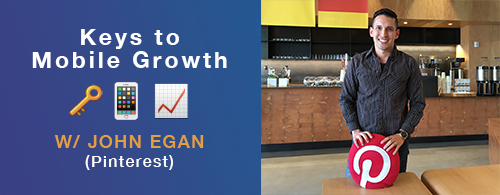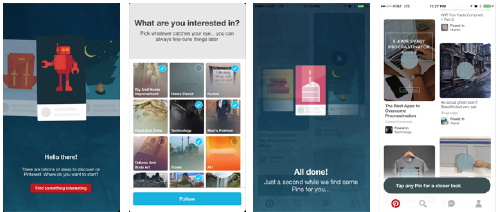For the 2nd edition of our Keys to Mobile Growth (???) content series, we had the chance to chat with John Egan, Growth Engineering Manager at Pinterest. Just a few blocks from our Flurry from Yahoo office in San Francisco, we met John in the dining area of Pinterest’s new and ultra-hip space.
John is one of the top growth minds in the industry and currently focuses on boosting mobile engagement through emails, push notifications and in-app experiences. Before Pinterest, he led the growth engineering team at Shopkick and grew their user base from 1 Million to 8 Million users. Check out his hands-on tips on how to pin-up your app’s activation and user retention rates.

Anything in quotes below is attributed to John Egan.
Understand how your growth model is structured
To optimize your user lifecycle, it’s important to align your initiatives with your ‘true north’ metric and understand your key growth levers. “At Pinterest, our main metric is Weekly Active Repinners (WARs). Once you have your main KPI, you can break it down in different parts that affect that metric. With Weekly Active Repinners, we look at how many active users we have and what percentage of them are repining.” Understanding how your key metric is defined and what elements can influence it, is the basis for implementing a successful growth model.
At Pinterest, the growth formula looks like this:
- Weekly Active Repinners (Main KPI) = Active Users x Percent of active Users repining this week
- Active Users = Sign-ups x Activation Rate – Churn + Resurrections
“Users repining per week is usually further broken down by the specific parts of our app. We then look at the conversion rates of someone engaging with a specific part to repining.“
The Foundations for successful user activation
As shown above, activation, churn rate and retention are key parameters for Pinterest’s Active User and consequently Weekly Active Repinners metric. “For activation, it all comes down to: Does the user get enough value from your product?
For early stage startups, this means to figure out how to reach product-market-fit. And if you’re past that stage, it comes down to being able to communicate your product value to your users. When someone downloads your app, you have a couple of minutes to convince them that this is something they need to use on a regular basis. In this short time they need to understand how the app will help them accomplish whatever the product value is.“
Activate first, educate later…
Finding the right first words for introducing your app to new users is not an easy task. “When I joined Pinterest, we focused on education and I think a lot of other apps do that too. We told new users that they can use Pinterest to discover things and can click the pin it button to save something to a board.” Make sure not to over-educate your user in the first seconds of using your app. The main purpose of your onboarding flow should be to highlight the core value that you’re delivering rather than explaining all app features in detail. ”If people understand the value at the beginning and you don’t make your UI crazy complex, they will spend some time on how to use your app if they know what the payoff will be.”
Personalize if you can
“In our old on-boarding flow, we dumped everyone on our Popular Feed after the signup and just showed them the most popular stuff. Unsurprisingly, a lot of people didn’t activate because at that time, the popular content was dominated by a few categories like home décor, women’s fashion, and wedding. So if that’s what you were interested in, then that’s great. Otherwise, the activation chances were rather low.”
Today, Pinterest utilizes their first app screens to learn more about the user, in order to personalize further experiences. This can be an impactful strategy to improve both activation and retention. This in mind, Pinterest allows their users to select topics they’re interested in to show them customized content afterwards.

“For Pinterest, all the value comes from connecting you with content that you might find interesting. And so, if you use the topic selector, this set ups your home feed. And because Pinterest can be used in a lot of different ways - people use Pinterest to accomplish a variety of things - we need to encourage our users to tell us what things are most relevant for them.“
Knowing the users’ interests lets Pinterest also tailor initiatives to reach the user outside of the app. “The topic selector also defines what content will be in the emails and push notifications that you’ll receive from us.” This allows Pinterest to customize retention campaigns to minimize churn rates.
Which channels make your users return?
If we leave out in-app experiences and paid retargeting; emails and push notifications are two of the most impactful retention channels for most app developers. To find out on which retention channel you should focus, it’s helpful to look at channel engagement and opt-in rates. “We see big differences for push notification opt-ins between Android & iOS. Basically, Android users are opted-out and iOS users are opted-in. Email is also a pretty big retention channel for us. Over half of our users open their emails on mobile devices. If the median push acceptance rate for iOS is 50%, and half of your iOS users are opening their emails on mobile, than email is just as impactful as push for your retention campaigns.“
How to make your users opt-in
“I think when people understand why they’re receiving push notifications or emails, it makes them a lot more receptive and less likely to unsubscribe to them. Community-oriented products like Facebook and Twitter are great examples where people get lots of emails and notifications and don’t turn them off because they understand why they’re getting them.” If you can leverage your users’ actions instead of general content, they are usually more likely to understand their relation to it. However, you should still make sure to control the volume of your emails and push notifications. The line between adding value and annoying your users can be very thin here.
Tie your retention campaigns back to your main metric
When developing new retention initiatives or testings, it’s crucial to estimate its potential impact before and measure the performance afterwards. “Let’s say we build out a new email type and we want to know how impactful that is. First, we think about what the addressable audience is. How many users are actually eligible to receive the new email type? Then you always need a hypothesis around that. In this case, it might be around the engagement rate of the email. How many clicks will you get for x numbers of deliveries? Looking at previous campaigns can usually be helpful to determine your estimate. And from there, we’d calculate how many more Weekly Active Repinners this initiative would bring.”
Let us know what you think about John’s user activation and retention tips in the comments below. We’ll continue our Keys to Mobile Growth series with more industry leaders and mobile experts. If you have someone in mind that you would like to hear from next, give us a shout.
#KeysToMobileGrowth